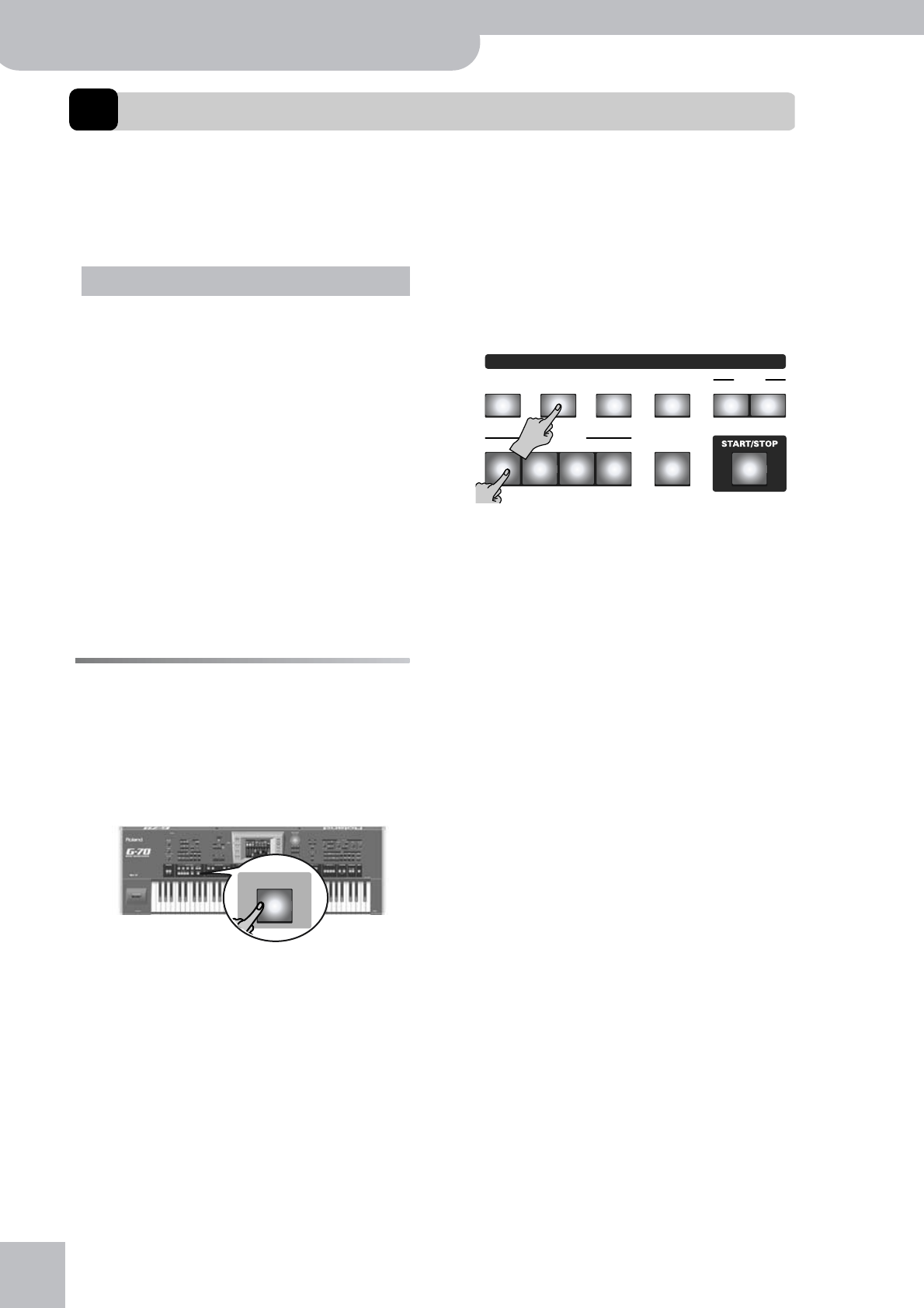
Additional Arranger/Style functions
74
r
G-70 Music Workstation
6. Additional Arranger/Style functions
Before telling you even more about the Music Styles, allow us to explain the difference between Music Styles and the
Arranger. The Arranger is a kind of sequencer that plays back the accompaniments you select. Those accompaniments
are always related to a given musical genre (or “style”), and are therefore called “Music Styles”. The G-70’s accompani-
ments are a lot more than just one pattern that goes on playing until you stop it: they comprise several patterns (or divi-
sions).
Each accompaniment (or Music Style) consists of up to
eight parts:
ADR: Accompaniment drums. This part takes care of the
rhythm section. It triggers the drum and percussion
sounds of the Drum Set assigned to the ADR part.
ABS: Accompaniment bass. This part plays the bass line
of the Music Style you select.
ACC1~ACC6: These are the melodic accompaniment
parts. Depending on the Music Style you selected, only
a few of them actually play something, which can be
anything from a piano line, a guitar line, an organ line,
etc., to synthesizer chords. Not all ACC parts play
chords, though.
The ABS and ACC1~6 parts rely on the chord or note
information you play in the chord recognition area
(page 80), i.e. the keyboard zone you assign to the
Arranger.
Playback functions (Style Control)
Starting a Music Style
Music Styles can be started in several ways:
(1) Press the EASY SETTING [ARR] button (its indicator
lights).
• Press the [START÷STOP] button (so that it lights) to
start the Arranger right away.
If you start the Arranger without playing a chord in
the chord recognition area beforehand, you will only
hear the drums of the selected Music Style. In most
cases, however, the G-70 has already memorized a
chord, so that you will hear the full accompaniment.
—OR—
• Stop playback of the current Style (see below), press
the [INTRO] button (so that it lights), one of the VARI-
ATION [1]~[4] buttons to select the “complexity” of
the introduction, and then the [START÷STOP] button.
This starts Style playback with a musical introduction.
The length of the Intro depends on the Style you
select. At the end of the Intro, the Arranger switches
to the Music Style pattern you selected with the
[MAIN] and one of the VARIATION buttons.
Note: The Intro is “renewable”, i.e. you can press the [INTRO]
button again while the Intro is playing. Doing so on the fourth
beat of the first Intro bar, for instance, will retrigger the begin-
ning of the Intro in the second bar.
—OR—
• Press the SYNC [START] button and play a chord (or
just one note in INTELLIGENT mode, see p. 80). In this
case, the Arranger starts as soon as you play a note or
chord in the chord recognition area (see p. 80).
Note: Do not play chord changes while the Intro is running.
Unlike the MAIN patterns, INTRO patterns usually contain
chord changes. Chord recognition is not deactivated during
Intro playback, so that the beginning of a song may jump from
one key to another in a rather unnatural way. This recognition
can be switched off, however, so that you do not have to worry
about it (see “Intro & Ending Alteration” on page 81).
Note: You can also start and stop the Arranger with the D
Beam controller (page 65).
Stopping Music Styles
There are three ways to stop Style playback:
• Press [START÷STOP] to stop playback right away.
—OR—
• Press the [END/RIT] button (so that it lights) and one
of the VARIATION [1]~[4] buttons to activate the End-
ing function. The Ending (or coda) pattern will start
at the beginning of the next measure (next down-
beat).
Note: Do not play chord changes while the Ending is running.
Unlike the MAIN accompaniments, Ending patterns usually
contain chord changes. Chord recognition is not deactivated
during Intro or Ending playback, so that the ending of a song
may jump from one key to another in a rather unnatural way.
This recognition can be switched off, however, so that you do
not have to worry about it (see p. 81).
—OR—
• Press SYNC [STOP] and release all keys in the chord
recognition area of the keyboard. The accompani-
ment stops immediately.
Arranger parts
START/STOP
INTRO MAIN END/RIT START STOP
BASS
INVERSION
AUTO
FILL IN
VARIATION
123 4
SYNC
STYLE CONTROL


















